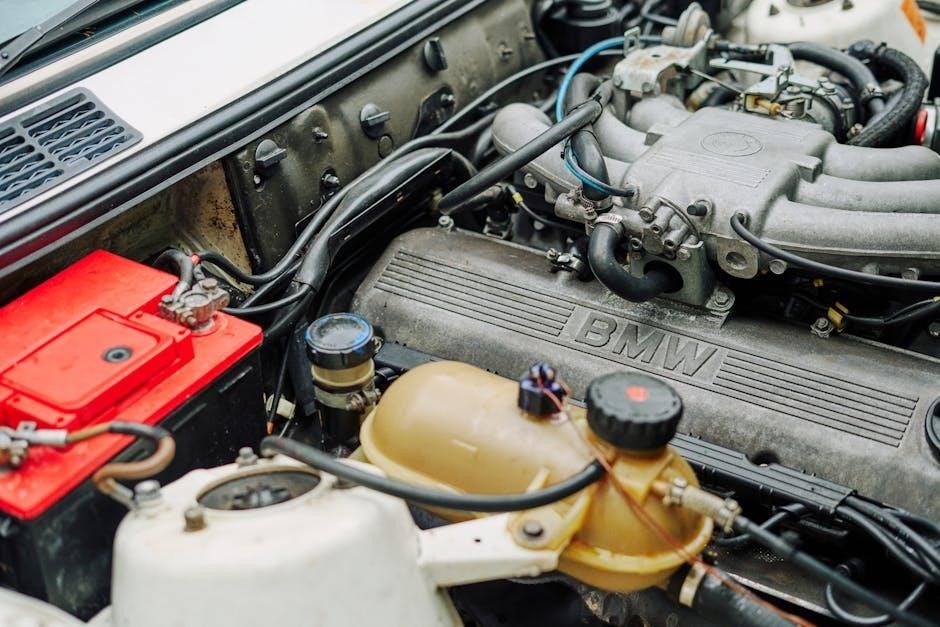1․1 Definition and Purpose of Car Manuals
Car manuals are detailed guides written for vehicle owners and drivers‚ providing essential information on operation‚ maintenance‚ and troubleshooting․ They cater to diverse audiences‚ including first-time owners and enthusiasts‚ ensuring safe and optimal vehicle use; Modern manuals now integrate interactive features‚ enhancing user experience through technology․
Car manuals are comprehensive guides designed to help drivers and owners understand their vehicles’ features‚ maintenance‚ and operation․ They serve as essential resources for safe and efficient driving‚ addressing the needs of various users‚ including first-time owners‚ enthusiasts‚ and professionals․ These manuals provide detailed instructions on troubleshooting‚ technical specifications‚ and best practices for vehicle care․ By catering to diverse audiences‚ car manuals ensure that users can optimize their driving experience․ Modern manuals also incorporate interactive and AI-powered features‚ enhancing accessibility and user engagement․ Their purpose is to empower drivers with knowledge‚ reducing confusion and promoting responsible vehicle ownership․ They are tailored to meet the specific needs of different demographics‚ ensuring clarity and practicality․
1․2 Importance of Car Manuals for Drivers
Car manuals are essential for drivers as they provide clear instructions on vehicle operation‚ maintenance‚ and troubleshooting․ They enhance user experience by offering step-by-step guides‚ minimizing confusion and ensuring safe driving practices․ Manuals act as valuable troubleshooting resources‚ helping drivers diagnose and address common issues․ They also include safety tips and guidelines‚ crucial for preventing accidents and maintaining the vehicle’s condition․ By understanding their car’s features and functions‚ drivers can optimize performance and extend the vehicle’s lifespan․ Modern manuals‚ especially AI-powered ones‚ offer real-time support‚ making them indispensable for both novice and experienced drivers․ They empower users to make informed decisions‚ reducing reliance on external assistance and fostering confidence behind the wheel․

Primary Audience of Car Manuals
Car manuals primarily target car owners and drivers‚ ensuring they understand vehicle operation‚ maintenance‚ and troubleshooting․ They cater to diverse demographics‚ including first-time owners and enthusiasts․
2․1 Car Owners and Drivers
Car manuals are primarily written for car owners and drivers‚ serving as a comprehensive guide to understanding and maintaining their vehicles․ These manuals provide detailed instructions on operating features‚ safety precautions‚ and routine maintenance․ They cater to both first-time owners‚ who may need step-by-step guidance‚ and experienced drivers seeking advanced troubleshooting tips․ The content is tailored to address common queries‚ ensuring drivers can resolve issues efficiently․ By focusing on clarity and accessibility‚ car manuals empower owners to maximize their vehicle’s performance and longevity․ They also highlight essential safety measures‚ making them an indispensable resource for all drivers․ This ensures a smooth and informed driving experience․
2․2 Demographic Segmentation of Car Owners
Car manuals are tailored for diverse demographic groups‚ including age‚ gender‚ income‚ education‚ and occupation․ Younger drivers may prioritize tech features‚ while older owners focus on simplicity․ Gender-specific needs‚ like safety for women or performance for men‚ are addressed․ Income levels influence content‚ with luxury car manuals detailing advanced features․ Education and occupation also play roles‚ as professionals may seek efficiency‚ while enthusiasts desire detailed technical specs․ Manuals adapt to these segments‚ ensuring relevance and accessibility․ By understanding demographic preferences‚ car manuals cater to individual needs‚ enhancing user experience and satisfaction․ This segmentation ensures that all owners‚ regardless of background‚ find value in their manual․
2․3 Psychographic Characteristics of Car Owners
Car manuals are also designed with psychographic characteristics in mind‚ such as lifestyle‚ values‚ and interests․ For instance‚ safety-conscious drivers prioritize features like emergency procedures‚ while performance-oriented enthusiasts seek detailed technical specifications․ Environmentally aware owners may focus on fuel efficiency and eco-friendly maintenance tips․ Additionally‚ lifestyle factors like family needs or recreational activities influence content‚ ensuring manuals address practical concerns․ Manuals further cater to hobbyists who enjoy customizing or modifying their vehicles․ By aligning with these psychographic traits‚ car manuals provide personalized guidance‚ enhancing user satisfaction and engagement․ This approach ensures that the manual resonates with the owner’s mindset and usage habits‚ making it a valuable resource․
2․4 Common Usage Scenarios for Car Manuals
Car manuals are primarily used during routine maintenance‚ troubleshooting‚ and understanding vehicle features․ Drivers often refer to them for oil changes‚ tire pressure checks‚ and other regular upkeep tasks․ Additionally‚ manuals are consulted during unexpected issues‚ like warning light explanations or fault diagnoses․ New car owners frequently use manuals to familiarize themselves with controls and settings․ Some drivers also use manuals to prepare for long trips or extreme weather conditions․ Furthermore‚ enthusiasts may explore advanced features or customization options․ These scenarios highlight the manual’s role as an essential resource for various driving situations‚ ensuring users can address challenges effectively and make informed decisions about their vehicle’s care and operation․
2․5 Challenges Faced by Car Owners in Using Manuals
Car owners often face challenges when using manuals‚ including complexity of technical language and lack of visual aids․ Many find the information overwhelming or difficult to interpret‚ especially for novice drivers․ Additionally‚ outdated content in printed manuals can lead to confusion‚ as vehicle technology advances rapidly․ Some drivers prefer interactive or digital formats but may not have access to them․ Language barriers can also pose issues for international users․ Furthermore‚ the abundance of information can make it hard to locate specific details quickly․ These challenges highlight the need for clearer‚ more user-friendly manuals that cater to diverse audiences and preferences‚ ensuring drivers can effectively utilize the guidance provided․

Secondary Audience of Car Manuals
Car manuals are also written for new car buyers‚ enthusiasts‚ mechanics‚ and family members‚ providing them with essential information for understanding and maintaining the vehicle effectively․
3․1 New Car Buyers
New car buyers benefit significantly from car manuals‚ as they provide detailed insights into the vehicle’s features‚ operation‚ and maintenance․ For first-time buyers‚ these guides are essential for understanding the specifics of their new purchase․ Manuals help buyers familiarize themselves with advanced technologies‚ safety features‚ and optimal driving practices․ They also include troubleshooting tips and maintenance schedules‚ ensuring the vehicle runs efficiently․ By offering clear instructions‚ car manuals empower new owners to make informed decisions and enjoy a seamless driving experience․ Additionally‚ interactive digital manuals are now enhancing user engagement‚ making complex information more accessible and user-friendly for this audience․ This support is crucial during the initial ownership period‚ helping buyers adapt to their new vehicle confidently․
3․2 Car Enthusiasts and Hobbyists
Car enthusiasts and hobbyists often delve deeply into the technical and performance aspects of their vehicles․ For this audience‚ car manuals serve as invaluable resources‚ providing detailed specifications‚ advanced diagnostics‚ and customization options․ Manuals cater to their passion for understanding and enhancing their cars‚ offering insights into engine performance‚ tuning‚ and maintenance․ Additionally‚ enthusiasts appreciate the troubleshooting guides and repair instructions that allow them to tackle complex tasks independently․ With the rise of AI-powered manuals‚ these users can now access interactive‚ real-time support‚ further enhancing their ability to optimize and personalize their vehicles․ This audience values manuals as tools that empower them to push their cars’ capabilities and reflect their dedication to automotive excellence․
3․3 Professional Mechanics and Technicians
Professional mechanics and technicians rely heavily on car manuals for precise technical specifications‚ wiring diagrams‚ and diagnostic procedures․ These manuals provide detailed instructions for complex repairs‚ ensuring accuracy and efficiency․ They often include troubleshooting guides‚ torque specifications‚ and service intervals‚ which are essential for maintaining and repairing vehicles effectively․ Additionally‚ manuals cater to technicians by offering step-by-step instructions for advanced tasks‚ such as engine overhauls or transmission replacements․ With the emergence of AI-powered manuals‚ professionals can access real-time updates and interactive diagnostics‚ enhancing their ability to address modern automotive challenges․ This audience values manuals as critical tools that enable them to deliver high-quality‚ professional service․
3․4 Family Members or Caregivers of Car Owners
Family members or caregivers of car owners often use car manuals to assist in vehicle maintenance‚ safety‚ and operation․ They may need to understand basic functions‚ safety features‚ and emergency procedures to support the primary driver․ Manuals provide clear instructions for tasks like changing tires or checking fluid levels‚ which are essential for caregivers․ Additionally‚ they may refer to sections on driving tips or troubleshooting to help manage the vehicle effectively․ With AI-powered manuals‚ caregivers can access real-time guidance‚ making it easier to assist drivers with specific needs․ This audience benefits from the manual’s comprehensive information‚ ensuring they can provide reliable support and maintain the vehicle’s condition․

Specialized Audiences for Car Manuals
Specialized audiences include first-time owners‚ safety-conscious drivers‚ tech-oriented users‚ and those in unique climates․ Manuals cater to their specific needs‚ offering tailored guidance and solutions․
4․1 First-Time Car Owners
First-time car owners often require detailed‚ easy-to-understand guidance to navigate vehicle operation and maintenance․ Car manuals are tailored to address their lack of experience‚ focusing on essential features‚ safety protocols‚ and routine upkeep․ They emphasize clear‚ step-by-step instructions to build confidence and ensure proper vehicle care․ These manuals also include troubleshooting tips and FAQs‚ catering to common concerns among new owners․ By providing comprehensive yet accessible information‚ they help first-time owners transition smoothly into responsible vehicle ownership‚ reducing anxiety and enhancing their driving experience․
4․2 Drivers with Specific Needs (e․g․‚ Safety-Conscious Individuals)
Car manuals are also written for drivers with specific needs‚ such as safety-conscious individuals who prioritize vehicle safety and reliability․ These manuals provide detailed information on advanced safety features‚ emergency procedures‚ and maintenance tips to ensure optimal vehicle performance․ For example‚ they often include instructions on using features like airbags‚ anti-lock braking systems (ABS)‚ and electronic stability control․ Additionally‚ manuals cater to drivers who require clarity on safety protocols‚ such as proper seatbelt usage and crash prevention technologies․ By addressing these specific needs‚ car manuals empower drivers to operate their vehicles confidently and responsibly‚ minimizing risks and enhancing overall driving safety․
4․3 Technologically Oriented Drivers
Car manuals are also tailored for technologically oriented drivers who seek advanced features and connectivity options in their vehicles․ These individuals often look for detailed instructions on infotainment systems‚ smartphone integration‚ and driver-assistance technologies․ Manuals now include sections on configuring settings for features like adaptive cruise control‚ lane-keeping assist‚ and voice command systems․ Additionally‚ they provide guidance on troubleshooting connectivity issues with Bluetooth‚ Wi-Fi‚ or USB interfaces․ For drivers who value innovation‚ manuals offer insights into updating software and accessing real-time data‚ such as fuel efficiency or performance metrics․ This ensures that tech-savvy drivers can fully utilize their car’s modern capabilities‚ enhancing their overall driving experience through technology․
4․4 Drivers in Unique Geographic or Climatic Conditions
Car manuals are also designed for drivers in unique geographic or climatic conditions‚ such as those living in extreme weather areas or remote regions․ These drivers often face challenges like snow‚ desert heat‚ or mountainous terrain․ Manuals provide specialized advice on adapting vehicles to these conditions‚ such as tire pressure adjustments‚ fluid checks‚ and driving techniques․ For example‚ drivers in snowy regions may find tips on using winter tires or handling icy roads․ Similarly‚ those in desert climates might learn about cooling system maintenance․ Manuals ensure these drivers can operate their vehicles safely and efficiently‚ regardless of environmental challenges‚ making them an essential resource for diverse driving environments․

Understanding the Target Audience
Car manuals are tailored for diverse drivers‚ including those with specific needs like safety-conscious individuals or technologically oriented users․ They cater to various preferences and driving habits․
5․1 Socio-Demographic Targeting
Car manuals are designed with specific socio-demographic groups in mind‚ such as age‚ gender‚ and income level․ For instance‚ younger drivers may prioritize tech-heavy features‚ while older drivers focus on simplicity․ Women‚ particularly those with families‚ often seek safety and practicality‚ as seen in Volvo’s designs․ Income levels also influence content‚ with luxury brands like BMW targeting higher-income individuals․ Manuals may emphasize advanced features for affluent buyers or affordability for budget-conscious owners․ By tailoring content to these demographics‚ car manuals ensure relevance and accessibility‚ addressing the unique needs of each group effectively․
5․2 Behavioral Targeting
Behavioral targeting in car manuals focuses on how drivers interact with their vehicles‚ tailoring content to their habits and preferences․ For example‚ frequent travelers receive tips on long-drive comfort and fuel efficiency‚ while city drivers get advice on parking and traffic navigation․ Enthusiasts who prioritize performance may find detailed specs and customization options․ Manuals also adapt to usage patterns‚ such as eco-friendly driving tips for environmentally conscious owners․ By aligning content with driver behavior‚ car manuals enhance user experience‚ making them more practical and relevant․ This approach ensures that the information provided meets the specific needs and behaviors of each driver‚ improving overall satisfaction and vehicle performance;
5․3 Interest-Based Targeting
Interest-based targeting in car manuals involves tailoring content to align with specific interests of drivers‚ enhancing relevance and engagement․ For instance‚ technologically oriented drivers receive detailed explanations of advanced features and infotainment systems․ Safety-conscious individuals find emphasized sections on emergency procedures and vehicle safety technologies․ Enthusiasts focused on performance gain insights into optimizing engine output and handling․ Manuals also cater to eco-friendly drivers by highlighting fuel-saving tips and hybrid vehicle specifics․ By understanding and addressing these interests‚ car manuals create a personalized experience‚ ensuring drivers access information that matters most to them․ This approach not only improves user satisfaction but also encourages safer and more efficient driving practices․

The Role of Car Manuals in Customer Support
Car manuals provide clear instructions‚ enhancing user experience by minimizing confusion and offering solutions to common issues‚ ensuring drivers can operate their vehicles safely and effectively․
6․1 Providing Clear Instructions
Car manuals are designed to provide clear‚ concise instructions for various audiences‚ ensuring drivers understand vehicle operation and maintenance․ They cater to first-time owners‚ offering step-by-step guides‚ and enthusiasts seeking detailed technical information․ Manuals ensure safety by explaining features like ADAS systems‚ helping safety-conscious individuals․ They also assist drivers in unique conditions‚ like extreme weather‚ with specific tips․ By addressing diverse needs‚ manuals empower users to make informed decisions‚ enhancing their driving experience and vehicle longevity․ This clarity is vital for minimizing confusion and maximizing user satisfaction‚ making manuals an essential resource for all car owners․
6․2 Enhancing User Experience
Car manuals enhance user experience by offering interactive and real-time support‚ making vehicle operation intuitive․ AI-powered manuals provide personalized guidance‚ reducing confusion and ensuring drivers access relevant information quickly․ They cater to diverse audiences‚ from first-time owners to enthusiasts‚ with features like troubleshooting guides and maintenance reminders․ Manuals also integrate multimedia‚ such as videos‚ to simplify complex tasks․ By addressing specific needs‚ like safety-conscious drivers or those in unique climates‚ manuals ensure a tailored experience․ This adaptability fosters a positive interaction‚ making manuals indispensable for optimal vehicle use and customer satisfaction․

6․3 Minimizing Confusion

Car manuals are designed to minimize confusion by providing clear‚ concise instructions tailored to various audiences‚ including first-time owners and experienced drivers․ They use simple language‚ diagrams‚ and step-by-step guides to ensure easy understanding․ AI-powered manuals further reduce confusion by offering real-time‚ interactive support‚ addressing specific user queries instantly․ These resources cater to diverse needs‚ such as safety-conscious individuals or those in unique climates‚ ensuring relevance․ By anticipating common issues and providing straightforward solutions‚ manuals help users navigate complexities with confidence․ This clarity enhances overall satisfaction‚ making manuals an essential tool for optimal vehicle operation and troubleshooting․

The Future of Car Manuals
The future of car manuals lies in AI-powered‚ interactive guides offering real-time assistance․ Integration with digital platforms enhances accessibility‚ reducing confusion and improving user experience․
7․1 AI-Powered Manuals
AI-powered car manuals revolutionize the way drivers interact with their vehicles by offering personalized‚ real-time assistance․ These manuals cater to a diverse audience‚ including tech-savvy drivers‚ first-time car owners‚ and safety-conscious individuals․ They provide interactive troubleshooting‚ voice-activated instructions‚ and predictive maintenance alerts‚ enhancing user experience․ AI-driven manuals also adapt to individual preferences‚ offering tailored advice based on driving habits and vehicle data․ This technology ensures clarity and efficiency‚ reducing confusion and empowering drivers to make informed decisions․ As automotive technology advances‚ AI-powered manuals will become indispensable‚ serving as a bridge between drivers and their vehicles for a safer‚ more efficient driving experience․
7․2 Interactive and Real-Time Support
Interactive and real-time support in car manuals is designed for drivers seeking immediate‚ dynamic assistance․ These features cater to tech-oriented individuals‚ offering voice-activated instructions‚ live diagnostics‚ and contextual guidance․ Real-time updates ensure users receive the most relevant information‚ enhancing safety and efficiency․ This technology is particularly beneficial for first-time car owners and those navigating unfamiliar terrain‚ providing instant solutions to common issues․ By integrating interactive elements‚ manuals become more engaging‚ reducing confusion and empowering drivers to address problems confidently․ This approach bridges the gap between traditional static guides and modern‚ adaptive support systems‚ ensuring a seamless driving experience tailored to individual needs․
7․4 Integration with Digital Platforms
Car manuals are increasingly being integrated with digital platforms‚ offering users seamless access to information via smartphones‚ tablets‚ and other devices․ This integration is particularly beneficial for tech-savvy drivers who prefer instant‚ on-the-go guidance․ Digital platforms enable real-time updates‚ ensuring manuals remain current with software updates and new features․ Interactive features like search functions‚ video tutorials‚ and diagnostics further enhance user experience․ This shift caters to younger‚ digitally native car owners who prioritize convenience and efficiency․ Additionally‚ integration with apps allows for personalized tips and notifications‚ making manuals more accessible and user-friendly for a broader audience‚ including those in unique geographic or climatic conditions who require tailored guidance․ This digital evolution ensures car manuals remain relevant in a rapidly changing automotive landscape․
Car manuals are essential resources for diverse audiences‚ including owners‚ drivers‚ and technicians‚ ensuring safe and efficient vehicle operation․ They cater to various needs‚ providing clear‚ accessible information․
8․1 Summary of Key Points
Car manuals are designed for a wide range of audiences‚ including car owners‚ drivers‚ enthusiasts‚ and professionals․ They provide essential information for safe and efficient vehicle operation‚ addressing diverse needs such as maintenance‚ troubleshooting‚ and customization; The primary audience includes everyday drivers seeking practical guidance‚ while secondary audiences like new buyers and technicians benefit from detailed specifications and diagnostic tips․ Specialized groups‚ such as first-time owners or safety-conscious individuals‚ also find value in these resources․ Additionally‚ the integration of AI and interactive features in modern manuals enhances accessibility and user experience‚ catering to technologically oriented drivers․ Overall‚ car manuals remain a vital tool for empowering users and ensuring optimal vehicle performance․
8․2 Final Thoughts on the Audience of Car Manuals
Car manuals are crafted to serve a diverse audience‚ ensuring all users can maximize their vehicle’s potential․ From everyday drivers seeking routine maintenance guidance to enthusiasts and professionals requiring detailed technical insights‚ these manuals cater to varying needs․ First-time owners‚ safety-conscious individuals‚ and technologically oriented drivers also benefit‚ as modern manuals integrate AI and interactive features․ The audience extends beyond individual owners‚ including family members‚ caregivers‚ and even new car buyers․ By addressing these groups‚ car manuals play a crucial role in enhancing user experience‚ minimizing confusion‚ and providing clear instructions․ Their evolution reflects the industry’s commitment to meeting the changing needs of drivers worldwide․

References
Sources include automotive industry reports‚ technical guides‚ and studies on driver behavior․ Key references are NHTSA‚ SAE‚ and AAA publications‚ focusing on vehicle safety and maintenance․
9․1 Sources of Information
Reputable sources include the National Highway Traffic Safety Administration (NHTSA)‚ Society of Automotive Engineers (SAE)‚ and automotive industry publications․ Additionally‚ academic studies on driver behavior and market research reports provide insights․ Digital platforms like Google Ads and Facebook Ads offer data on targeting strategies․ Manufacturer-specific resources‚ such as BMW’s demographic segmentation and Volvo’s YCC initiative‚ highlight audience-centric approaches․ AI-powered car manual studies and interactive guide analyses further enrich the understanding․ These sources collectively offer a comprehensive view of the diverse audiences car manuals are designed to serve‚ ensuring the content remains relevant and accessible․
9․2 Further Reading and Resources
For deeper insights‚ explore automotive publications like Motor Trend and Car and Driver․ Online forums such as Reddit’s r/cars and specialized groups for enthusiasts offer practical advice․ Manufacturer websites‚ like BMW and Volvo‚ provide detailed guides and case studies․ Academic journals on driver behavior and technology integration are also valuable․ E-books and whitepapers from automotive research firms shed light on emerging trends․ Digital libraries like IEEE Xplore and SAE Mobilus offer technical insights․ Additionally‚ resources on AI-driven manuals and interactive platforms highlight future directions․ These resources collectively provide a wealth of knowledge for understanding the evolving nature of car manuals and their target audiences․
